Digital Posters
Brain in Healthy Elderly & Dementia
ISMRM & SMRT Annual Meeting • 15-20 May 2021

| Concurrent 6 | 13:00 - 14:00 |
1924. |
Multimodal MR imaging reveals distinct sensitivity of hippocampal subfields to normal aging and asymptomatic Alzheimer's disease pathology
Junjie Wu1, Syed S. Shahid2,3, Qixiang Lin2, Antoine Hone-Blanchet2, Jeremy L. Smith1, Benjamin B. Risk4, Aditya S. Bisht2, David W. Loring2, Felicia C. Goldstein2, Allan I. Levey2, Bruce A. Crosson2,5, James J. Lah2, and Deqiang Qiu1,6
1Department of Radiology and Imaging Sciences, Emory University School of Medicine, Atlanta, GA, United States, 2Department of Neurology, Emory University School of Medicine, Atlanta, GA, United States, 3Department of Radiology and Imaging Sciences, Indiana University School of Medicine, Indianapolis, IN, United States, 4Department of Biostatistics and Bioinformatics, Emory University Rollins School of Public Health, Atlanta, GA, United States, 5Center for Visual and Neurocognitive Rehabilitation, Atlanta VA Medical Center, Decatur, GA, United States, 6Joint Department of Biomedical Engineering, Emory University and Georgia Institute of Technology, Atlanta, GA, United States
Using structural, resting-state functional and diffusion MRI, we report that normal aging affects functional connectivity and tissue microstructure in all hippocampal subfields, while the subiculum and CA1-3 exhibit the greatest sensitivity to asymptomatic Alzheimer’s disease pathology with CA1-3 hyperconnectivity. The imaging measures correlate with neuropsychological performance and CSF tau.
|
|||
1925.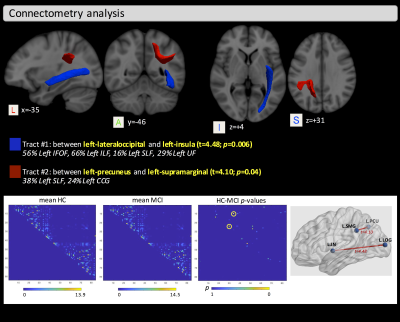 |
Analysis of brain structural connectivity networks and white matter integrity in patients with mild cognitive impairment
Maurizio Bergamino1, Ryan R Walsh2, and Ashley M Stokes1
1Neuroimaging Research, Barrow Neurological Institute, Phoenix, AZ, United States, 2Muhammad Ali Parkinson Center at Barrow Neurological Institute, Phoenix, AZ, United States
The objective of this study was to analyze the differences in structural connectivity and white matter (WM) microstructural integrity between healthy subjects and a cohort of individuals with mild cognitive impairment (MCI). For this purpose, we used a novel approach incorporating multi-shell diffusion MRI data from the Alzheimer’s Disease Neuroimaging Initiative (ADNI) database.
|
|||
1926.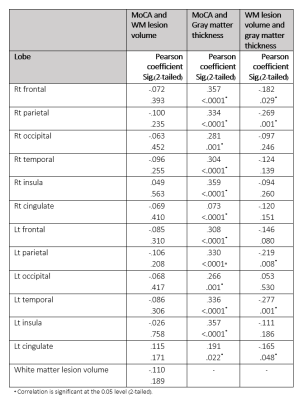 |
Correlation of gray matter thickness, gray matter volume, white matter lesion and clinical scoring in normal healthy elderly in Thailand
Tharathorn Kaeowirun1, Chanon Ngamsombat1, Doonyaporn Wongsawaeng 1, Siriwan Piyapittayanan1, Yudthaphon Vichianin2, Weerasak Muangpaisan3, Panida Charnchaowanish1, and Orasa Chawalparit1
1Department of Radiology, Faculty of Medicine, Siriraj Hospital, Mahidol University, Bangkok, Thailand, 2Department of Radiological Technology, Faculty of Medical Technology, Mahidol University, Bangkok, Thailand, 3Department of Preventive and Social Medicine, Faculty of Medicine, Siriraj Hospital, Mahidol University, Bangkok, Thailand
A simple screening tool such as MoCA has been used for demonstrating cognitive change even in normal aging process. Brain MRI has been used to demonstrate the etiology of cognitive problem in elderly. Structural changes by both visual assessment and automated methods can be obtained using MR study. We demonstrated the differences of structural parameters including cortical thickness, volume and white matter lesions(nonspecific white matter change) with a clinical MoCA test in normal aging population.
|
|||
1927.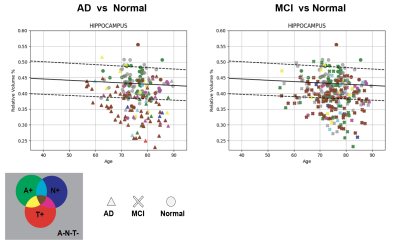 |
Volumetric analysis of brain MRI to distinguish healthy controls from AD and MCI patients according to ATN classification
Ilaria Ricchi1,2,3, Ricardo Corredor-Jerez1,2,3, Thierry Phénix4, Mélanie Leroy5, Reto Meuli2, Jonas Richiardi2, Bénédicte Maréchal1,2,3, and Jean-François Demonet4
1Advanced Clinical Imaging Technology, Siemens Healthcare AG, Lausanne, Switzerland, 2Dept. of Radiology, Lausanne University Hospital and University of Lausanne, Lausanne, Switzerland, 3LTS5, École Polytechnique Fédérale de Lausanne (EPFL), Lausanne, Switzerland, 4Leenaards Memory Centre CHUV Lausanne University, Lausanne, Switzerland, 5Lille Neuroscience & Cognition, Lille University, Inserm University Hospital CHU, Lille, France
The Amyloid, Tau, Neurodegeneration (ATN) classification model is defined by the concentration of biomarkers in the cerebrospinal fluid (CSF) and the positivity of imaging markers using MR or PET imaging. Despite the CSF biomarkers requiring an invasive procedure, they are good predictors for Alzheimer’s Disease. We investigate the contribution of automated brain MR morphometry analysis to discriminate between healthy subjects and dementia patients according to the ATN classification. Hippocampal and temporal gray matter volumes allow a substantial distinction between healthy participants with amyloid negativity and patients with an Alzheimer’s CSF profile in the T category.
|
|||
1928.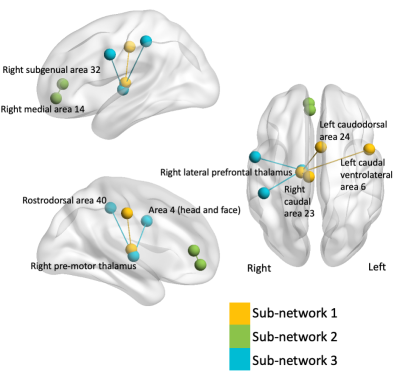 |
Increased Body Mass Index Associated with Reduced Connectivity in Functional Brain Networks in those At-Risk of Dementia
Marilena M DeMayo1,2, Jinglei Lv1,2, Shantel Duffy3,4,5, Sharon Naismith3,4,5,6, and Fernando Calamante1,2,7
1School of Biomedical Engineering, The University of Sydney, Camperdown, Australia, 2Brain and Mind Centre, The University of Sydney, Camperdown, Australia, 3Cogsleep, Australian National Health and Medical Research Council Centre of Research Excellence, Camperdown, Australia, 4Charles Perkins Centre, The University of Sydney, Camperdown, Australia, 5Healthy Brain Ageing Program, Brain and Mind Centre, The University of Sydney, Camperdown, Australia, 6School of Psychology, Faculty of Science, The University of Sydney, Camperdown, Australia, 7Sydney Imaging, The University of Sydney, Camperdown, Australia
Greater body mass index (BMI) is increasingly recognised as a risk factor for the development of dementia. This study investigated the functional connectivity networks associated with BMI using Network-Based Statistics in a cohort at-risk of developing dementia. Greater BMI was associated with decreased connectivity within 3 networks. Two of these networks showed decreased thalamo-cortical coupling and the third showed reduced connectivity between two nodes in the frontal cortex. This study illustrates the influence of BMI on functional connectivity, and a potential mechanism through which higher BMI confers risk of conversion from an at-risk clinical state to a dementia diagnosis.
|
|||
1929.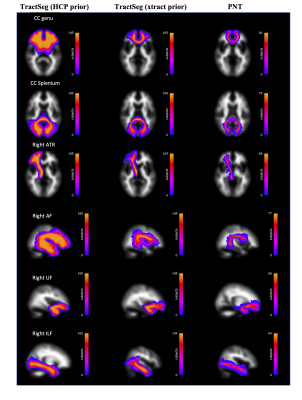 |
Automatic tract segmentation in the older brain
Susana Muñoz Maniega1, Jonathan D Clayden2, Maria Valdés Hernandez1, Mark E Bastin1, Ian J Deary3, and Joanna M Wardlaw1
1Centre for Clinical Brain Sciences, University of Edinburgh, Edinburgh, United Kingdom, 2UCL GOS Institute of Child Health, University College London, London, United Kingdom, 3Department of Psychology, University of Edinburgh, Edinburgh, United Kingdom
TractSeg automatically produces fast and accurate tract segmentations in young populations, but its robustness to changes in the brain due to aging has not been tested. We run TractSeg in data from an older cohort (age 82). We visually assessed the tract segmentations and compared diffusion parameters with a method previously tested in older brains (PNT). TractSeg produced reasonable tract segmentations. The agreement with PNT was poor but measurements were highly correlated. Visual assessments and estimated overlap between segmented bundles suggest potential over-segmentation and subsequent loss of specificity of tract diffusion parameters. Optimised training data could improve TractSeg’s results.
|
|||
1930.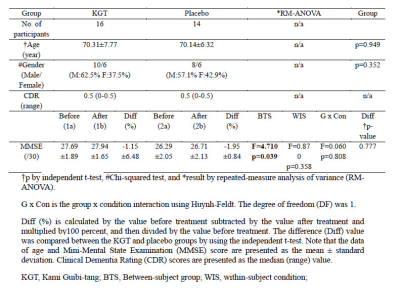 |
Application of SVS-PRESS, MEGA-PRESS, and pCASL to Evaluate Treatment Effect of Kami Guibi-tang in Patients with Mild Cognitive Impairment
Geon-Ho Jahng1, Seung-Yeon Cho2, Jung-Mi Park2, Soonchan Park1, Chang-Woo Ryu1, and Richard Edden3
1Radiology, Kyung Hee University Hospital at Gangdong, Seoul, Korea, Republic of, 2Stroke and Neurological Disorders Center, Kyung Hee University Hospital at Gangdong, Seoul, Korea, Republic of, 3Radiology, The Johns Hopkins University School of Medicine, Baltimore, MD, United States
This study aims to evaluate the effectiveness of herb medicine in the treatment of mild cognitive impairment (MCI) using SVS PRESS MRS, MEGA-PRESS, and pCASL MRI. We randomly allocated a total of 30 MCI patients to an herb medicine or a placebo group and performed MRI scans before and after 24 weeks of treatment. We analyzed NAA/Cr, GABA/Cr, and cerebral blood flow (CBF) using repeated-measure analysis of variance (ANOVA). We found that the CBF measures were the most sensitive markers to evaluate the effect of the herb medicine on MCI.
|
|||
1931.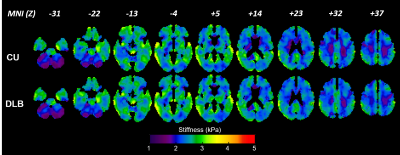 |
Impact of Dementia with Lewy Bodies on Brain Biomechanical Properties
KowsalyaDevi Pavuluri1, John Huston III1, Richard L. Ehman1, Armando Manduca1,2, Clifford R. Jack Jr1, Rodolfo Savica3, Bradley F Boeve4, Kejal Kantarci1, David S Knopman3, Ronald C. Petersen3, and Matthew C. Murphy1
1Department of Radiology, Mayo Clinic, Rochester, MN, United States, 2Department of Physiology and Biomedical Engineering, Mayo Clinic College of Medicine, Rochester, MN, United States, 3Department of Neurology, Mayo Clinic, Rochester, MN, United States, 4Division of Pulmonary and Critical Care Medicine, Mayo Center for Sleep Medicine, Mayo Clinic, Rochester, MN, United States
Dementia with Lewy Bodies (DLB) is the second most common neurodegenerative dementia in older people after Alzheimer’s, accounting for 10-15% of all dementia cases. In this study we used Magnetic Resonance Elastography (MRE) to assess the feasibility of using the changes in brain mechanical properties as potential biomarkers.
|
|||
1932.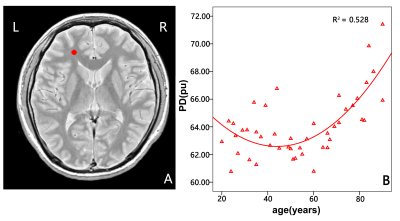 |
Investigation of brain regional relaxation characteristics in healthy subjects during normal aging using synthetic MRI
Di Wang1, Lu Yu2, Pu-Yeh Wu3, Chunmei Li2, and Min Chen2
1Beijing Hospital, National Center of Gerontology; Institute of Geriatric Medicine, Chinese Academy of Medical Sciences, P.R. China, Bejing, China, 2Beijing Hospital, National Center of Gerontology; Institute of Geriatric Medicine, Chinese Academy of Medical Sciences, P.R. China, Beijing, China, 3GE Healthcare, Beijing, China, Beijing, China
Synthetic MRI is a novel method that simultaneously provides quantitative relaxation mapping and synthetic contrast-weighted images. In this study, we adopted this technique to investigate the age-related relaxation characteristics alterations in healthy subjects by brain region-based regression analysis. Specifically, we found significant differences of relaxation characteristics between left and right hemispheres in the frontal and occipital white matter, and the genu and splenium of corpus callosum. T1, T2 and PD showed a quadratic trend with age. Overall, our findings suggested that the relaxation characteristics provided by the synthetic MRI can be considered an effective tool for detecting brain aging.
|
|||
1933.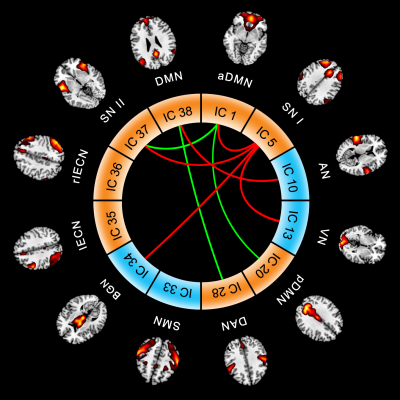 |
Altered resting-state network connectivity in patients with presbycusis
fei gao1, fuxin ren1, weibo chen2, and muwei li3
1Shandong Medical Imaging Research Institute, Shandong University, jinan, China, 2Philips Healthcare, shanghai, China, 3Vanderbilt University Institute of Imaging Science, Nashville, TN, United States
Presbycusis (PC) is a gradually progressive bilateral symmetrical sensory-neural hearing loss, characterized by hearing loss at high frequencies. As the most common sensory deficit in older adults, hearing deprivation was proved to be the independent influencing factor of dementia. However, the exact pathophysiological mechanism of PC and its relationship with cognitive impairment is largely unknown. In this study, therefore, we applied an ICA-based resting-state networks (RSNs) analysis to examine changes in functional connectivity of intra- and inter-network in patients with PC. Then, we explore the relationship between these abnormal functional connectivity and cognitive impairments in PC patients.
|
|||
1934.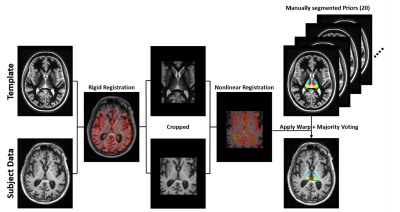 |
Thalamic nuclei changes in prodromal and clinical Alzheimer’s disease
Adam S Bernstein1, Steve Z Rapcsak2, Michael Hornberger3, and Manojkumar Saranathan4
1College of Medicine, University of Arizona, Tucson, AZ, United States, 2Department of Neurology, University of Arizona, Tucson, AZ, United States, 3Department of Medicine, University of East Anglia, Norwich, United Kingdom, 4Department of Medical Imaging, University of Arizona, Tucson, AZ, United States
Using a novel multi-atlas segmentation technique, we studied the atrophy of thalamic nuclei as a function of disease progression in Alzheimer’s disease. We found statistically significant atrophy of the anteroventral, centromedian, and mediodorsal nuclei, which are part of the limbic system and known to play a known role in memory and cognitive function. We also found atrophy of the medial geniculate nucleus and the pulvinar nucleus. The degree of atrophy increases from early MCI to full AD. These findings suggest that a larger network of brain structures are affected in Alzheimer’s disease, which together lead to the clinical presentation.
|
|||
1935.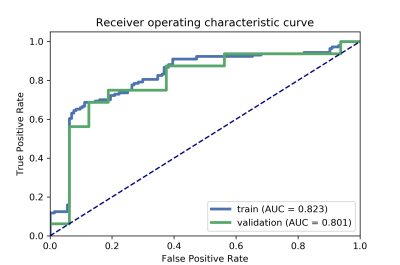 |
The changes of hippocampus in Type 2 Diabetes Mellitus Patients with Mild Cognitive Impairment: A Multiple Advanced Diffusion Models study
Mengzhu Wang1, Yunzhu Wu1, and Wenjiao Lyu2
1MR Scientific Marketing, Siemens Healthcare, Guangzhou, China, 2Department of Radiology, the First Affiliated Hospital of Guangzhou University, Guangzhou, China
The aim of this study was to elucidate a multiple diffusion-model-based radiomics model in detecting the changes of hippocampus in Type 2 Diabetes Mellitus Patients with Mild Cognitive Impairment. We used diffusion features derived from DTI, DKI, NODDI and MAP-MRI models and chose LR as the classifier to construct a prediction model. The results showed that the most accurate prediction was achieved by incorporating the NODDI_ICVF and MAP_NG into a nomogram, with AUC and accuracy reached 0.80 and 0.78.
|
|||
1936.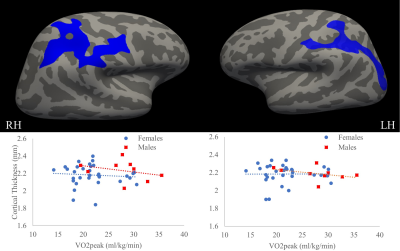 |
Cardiovascular fitness does not influence relationships between cortical thickness and obesity in aging
Brittany Intzandt1,2,3, Safa Sanami4, Julia Huck4, Richard D Hoge5, Louis Bherer2,3,6,7, and Claudine J Gauthier3,4,6
1INDI Department, Concordia University, Montreal, QC, Canada, 2Centre de Recherche de l'Institut Universitaire de Geriatrie, Montreal, QC, Canada, 3Centre de Recherche, l'Institut de Cardiologie de Montréal, Montreal, QC, Canada, 4Physics Department, Concordia University, Montreal, QC, Canada, 5Department of Neurology and Neurosurgery, McGill University, Montreal, QC, Canada, 6PERFORM Centre, Concordia Univeristy, Montreal, QC, Canada, 7Départment de Médicine, Université de Montréal, Montreal, QC, Canada
Cortical thinning occurs during aging and has been reported to worsen with increased adiposity, although this relationship seems dependent on sex. Increased cortical thickness is related to greater cardiovascular fitness in aging, but previous work has not explored if fitness moderates these conflicting relationships between overweight and cortical thinning. Here, we investigated if fitness moderates relationships between overweight status and cortical thickness in older women and men. Results revealed overweight women had greater cortical thickness than overweight men, but fitness did not moderate this. Future work should investigate sex hormones to further understand these sex differences in overweight individuals.
|
|||
1937.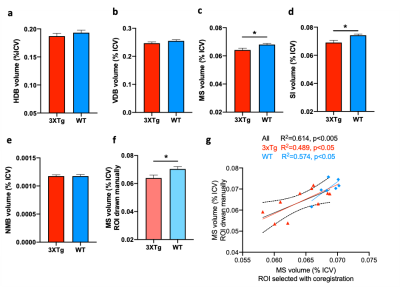 |
Does basal forebrain volume reduction in MRI indicate cholinergic degeneration? A validation study in mouse model of Alzheimer’s Disease
Xiaoqing Alice Zhou1, Grace Ngiam1, Lei Qian2, Tammy Sankorrakul3, Elizabeth J Coulson2, and Kai-Hsiang Chuang4
1QBI/SBMS, The University of Queensland, Brisbane, Australia, 2SBMS/QBI, The University of Queensland, Brisbane, Australia, 3SBMS, The University of Queensland, Brisbane, Australia, 4QBI/CAI, The University of Queensland, Brisbane, Australia 3xTg mouse model of AD have smaller basal forebrain volume measured by MRI MRI-detected volume changes do not correlate with cholinergic neurons |
|||
1938.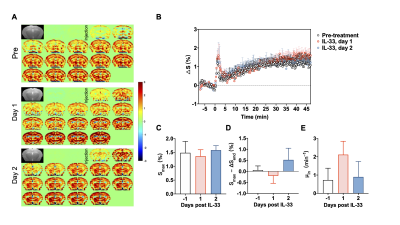 |
DGE-MRI detects the therapeutic effect of IL-33 in Alzheimer’s mice by assessing cerebral glucose uptake and clearance at 3T
Zilin Chen1, Jianpan Huang1, Yang Liu1, Joseph H.C. Lai1, and Kannie W.Y. Chan1,2,3
1Biomedical Engineering, City University of Hong Kong, Hong Kong, Hong Kong, 2Russell H. Morgan Department of Radiology and Radiological Science, The Johns Hopkins University School of Medicine, Baltimore, MD, United States, 3City University of Hong Kong Shenzhen Research Institute, Shenzhen, China
We have demonstrated that D-glucose kinetics detected by dynamic glucose-enhanced (DGE)-MRI can be used to assess D-glucose uptake and clearance alterations in Alzheimer’s disease (AD) mice at 3T. Interleukin (IL)-33 treatment has been shown to promote Aβ clearance. Here, we applied our established DGE-MRI to detect changes of brain clearance after IL-33 treatment in cerebrospinal fluid (CSF) and brain parenchyma in AD mice. A significant increased D-glucose clearance from CSF, but not brain parenchyma, was observed after treatment. DGE-MRI provides a non-invasive evaluation of IL-33 treatment in AD, and further affirm its potential to assess brain lymphatic system in AD.
|
|||
1939.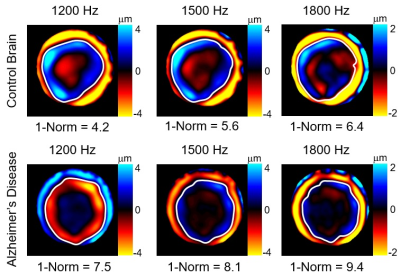 |
1-Norm for quantifying the degree of brain tissue mechanical inhomogeneity due to neurodegenerative disease
Harish Palnitkar1, Shreyan Majumdar2, Rolf Reiter3, Shujun Lin2, Joseph Crutison2, Thomas Royston2, and Dieter Klatt2
1Department of Mechanical and Industrial Engineering, University of Illinois at Chicago, Chicago, IL, United States, 2Richard and Loan Hill Department of Bioengineering, University of Illinois at Chicago, Chicago, IL, United States, 3Charite Universitatsmedizin, Berlin, Germany
In prior investigations, we have established 1-Norm as a quantitative measure of degree of inhomogeneity of excised biological tissues. Here, we apply 1-Norm to study effect of Alzheimer’s disease on mechanical inhomogeneity of brain. MRE was performed on excised brains of 3 control mice & 3 mice with AD(5xFAD). 1-Norm revealed increase in mechanical inhomogeneity of brain tissue due to AD. We speculate this increase in mechanical inhomogeneity of brains with AD may be due to amyloid plaque deposition, synaptic degeneration, neuronal loss & loss of white matter tracts. We aim to establish 1-Norm as a biomarker to detect AD in humans.
|
|||
1940.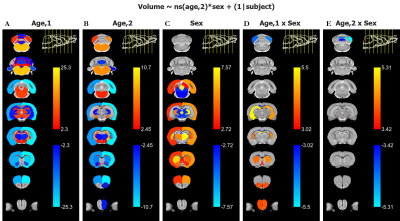 |
Longitudinal Characterization of Volumetric Changes During Healthy Aging and Between Sexes in the Fischer 344 Rat Brain
Dana Goerzen1,2, Caitlin Fowler1,2, Dan Madularu3, Gabriel A Devenyi2, M. Mallar Chakravarty1,2, and Jamie Near1,2
1McGill University, Montreal, QC, Canada, 2Centre d'Imagerie Cérébrale, Douglas Mental Health University Institute, Montreal, QC, Canada, 3Center for Translational Neuroimaging, Northeastern University, Boston, MA, United States
In order to design effective interventions for age-related diseases, it is necessary to first understand the biological processes associated with healthy aging. In this way, physiological changes during aging can be distinguished from those arising due to pathology. To this end, we present a comprehensive analysis of MRI-derived volumetric brain changes during healthy aging in a mixed-sex cohort of 27 Fischer 344 wildtype rats. These findings contribute to our understanding of the baseline neuroanatomical changes associated with healthy aging in both sexes, critical for the proper identification and management of age-related diseases, which frequently present in sexually dimorphic ways.
|
|||
1941.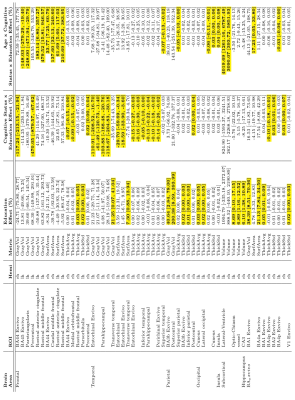 |
Testing the cognitive reserve hypothesis in the non-Western populations: evidence from a multicentric neuroimaging study in India
Brenton James Keller1, Jorge Jovicich2, Himanshu Joshi3, Leon Aksman4, John John3, A. B. Dey5, Arthur Toga4, Eileen Crimmins6, and Jinkook Lee1
1CSCR, University of Southern California, Los Angeles, CA, United States, 2Center for Mind/Brain Sciences (CIMEC),, University of Trento, Trento, Italy, 3Multimodal Brain Image Analysis Laboratory, National Institute of Mental Health and Neurosciences, Bangalore, India, 4Laboratory of Neuro Imaging, University of Southern California, Los Angeles, CA, United States, 5All India Institute of Medical Sciences, New Delhi, India, 6Davis School of Gerontology, University of Southern California, Los Angeles, CA, United States
Education offers neuroprotective effects against the progression of dementia. Limited information exists about such effects in non-Western populations, where formal education can be critically reduced. Here we examined dementia and education effects on brain morphometry in elderly healthy and mild cognitive impaired Indians. Morphometry revealed atrophy in areas typically related to MCI, enlarged lateral ventricles and reduced hippocampal volume. Education increased cortical thickness atrophy in the parahippocampal and temporal cortices (MCI group). This supports the cognitive reserve hypothesis, in which inter-individual differences in task processing is believed to allow some individuals to better cope with the neuropathology associated with dementia.
|
|||
1942. |
Early Stage Diagnosis of Alzheimer’s Disease Employing DTI-Derived Biomarkers
Forough Sodaei1,2, Jafar Zamani1,3, Maryam noroozian4, and Hamidreza Saligheh Rad1,5
1Quantitative MR Imaging and Spectroscopy Group, Research Center for Cellular and Molecular Imaging, Tehran University of Medical Sciences, Tehran, Iran (Islamic Republic of), 2Department of Medical Physics and Biomedical Engineering, School of Medicine, Tehran University of Medical Sciences, Tehran, Iran (Islamic Republic of), 3Department of Electrical Engineering, Iran University of Science and Technology, Tehran, Iran (Islamic Republic of), 4Memory and Behavioral Neurology Department, Roozbeh Hospital, Tehran University of Medical Sciences, Tehran, Iran (Islamic Republic of), 5Department of Medical Physics and Biomedical Engineering, School of Medicine, Tehran, Iran (Islamic Republic of)
Morphologic alterations of AD have been conventionally associated with the cerebral cortex; however, it is clear that other areas of the brain, especially the hippocampus are also involved. These structures, together with white matter structures including fornix constitute the limbic system, which is anatomic substrate of the memory system. Neurodegeneration in these areas lead to clinical manifestation of AD. In this study, we evaluated integrity of the limbic-associated areas in three groups using DTI. Findings yielded that the DTI-derived indices of the limbic-associated areas offer potential biomarkers for early and differential diagnosis of AD.
|
|||
1943.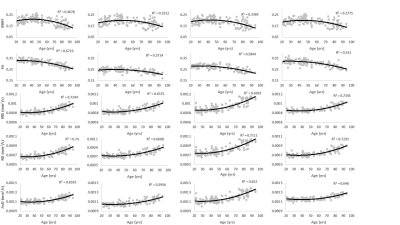 |
Maturation and degeneration of the human cerebrum across the adult lifespan
Matthew Kiely1, Nikkita Khattar1, Curtis Triebswetter1, Zhaoyuan Gong1, Maryam H. Alsameen1, Richard G. Spencer1, and Mustapha Bouhrara1
1Laboratory of Clinical Investigation, National Institute on Aging, Baltimore, MD, United States
Using myelin water fraction (MWF) and DTI, we investigated age- and sex-related differences in brain maturation and degeneration in a large cohort of unimpaired participants. We observed quadratic relationships between MWF or DTI indices and age, suggesting that brain maturation continues until middle age followed by a phase of rapid degeneration afterward. Sexual dimorphism in these processes was not significant in most cerebral regions studied. Finally, we observed weak-to-moderate correlations between DTI indices and MWF indicating that these indices could not serve as proxies of myelin content while highlighting the value of using multiple quantitative MRI metrics in clinical investigation.
|
The International Society for Magnetic Resonance in Medicine is accredited by the Accreditation Council for Continuing Medical Education to provide continuing medical education for physicians.